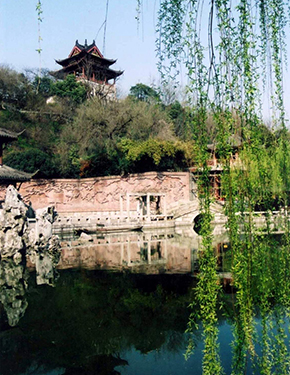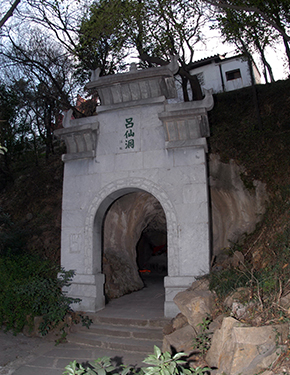
Cave of Immortal Lü
- Nomal
- Enlarge
- Reduce
This cave, aka Cave of Master Lü, is excavated on the basis of this immortal’s tale. It hides away 73 m northeast of Yellow Crane Tower and 206 m west of White Cloud Pavilion.
Immortal Lü was Lü Yan styled Dongbin. During Emperor Wuzong’s Huichang Period (841-846), he failed in two imperial examinations and then wandered around. This man visited celestials and Taoist priests. In this way, he finally met Zhongli Quan who taught him the elixir instructions. Thus Lü cultivated Taoism in Zhongnan Mountains and wandered everywhere. Why does Yellow Crane Tower have many tales and relics about him? The reason is that he allegedly cultivated immortalhood here. From Northern Song Epoch, tales about Lü had spawned. Especially when it came to Yuan, he was titled “Imperial Lord of Pure Yang Who Teaches Orthodoxy, Exhorts to Deliverance and Saves the Needy.” And Lü is even ranked among the Top 5 Patriarchs by Complete Perfection Sect—the Northern Lineage of Taoism. Later legend has him becoming one of “Eight Immortals” pervading the folklore. Increased prestige won him the greatest popularity for folks from Ming Era. Hence, Lü was allegedly associated with many scenic spots and places of interest, such as this cave.
In Song and Yuan texts, Lü is said to have done two things: first, wrote the poem “When a flute is played in Yellow Crane Tower, white duckweeds and red knotweeds thrive on the riverside. Who can know what goes on in my heart? Only the brisk zephyr and the bright moon.” second, “wandered around Jiangzhou and ascended Yellow Crane Tower, where he rose to heaven at noon of the 20th Day of the 5th Month in that year.” Then folks believed that he had visited the tower and painted a crane on the wall. Beyond that, many tales about the tower like “Riding a Crane to Heaven,” “Bearing Jujubes as Big as Melons” and “Throwing Peaches against the Rock Mirror” took him as the sheer protagonist. In the Yellow Crane Tower Scenic Area, among other memorial spots and buildings, “Cave of Immortal Lü,” “Crane-Riding Pavilion,” “Pavilion of Immortal Jujube,” “Site of Immortal Peach,” “Tower of Master Pure Yang,” “Pavilion of Patriarch Lü” came in multitude. But actually, this cave had emerged much earlier. Lu You’s My Journey to Shu mentions “a cottage is erected beside the cave in which Lü’s statue stands on end.” It is obvious that some spots had been imbued with the tales of him.
Common people hold a popular belief in him such that even his name has an origin story. According to this story, he had a family name called Li and a wife surnamed Jin. They led a happy married life.
One day, an old Taoist foretold this couple would meet a disaster and die tragically. When asked the solution, the priest said, “Now go to Yellow Crane Tower and cultivate Tao there. Perhaps you may survive the disaster.” In this way, they came to Snake Mountain and found this natural cave inscribed with “Huang He Dong (Yellow Crane Cave).” They had secluded themselves therein for austerity. As there was no other people except them, the couple surnamed themselves Lü (Two Mouths in Chinese character) and befriended none other than mountains rocks (Yan in Chinese). Such is the provenance of Lü Yan. He sighed for the transience of human life and named himself Dongbin “Cave-Dweller”. Later his wife died, Lü styled himself “Master Pure Yang (female indicates yin according to Chinese metaphysics),” Anyway, this unauthentic story is interesting.
The present cave was somewhat expanded on the original one. Inside the U-shaped cave, visitors can see an alabaster crouching statue of Master Lü along with artifacts like thurible. With 3.1 m length, 1.71 m height and 5 ton weight, this statue brings to life the master wearing a calm look. The cave-gate even has a bluestone arch. The cave-name is the handwriting of Feng Mu, former member of the Secretariat of Chinese Writers Association.

Tourist Service
- consulting hotline
Service hotline: 027-88875096
Supervision hotline: 027-88848188
027-12301
(Wuhan Tourism Bureau.)
027-87124701
(Hubei Tourism Administration)
- Official qr code.

Scan focuses on the yellow crane tower.
- Online consultant
- Complaint and advice






